From November 11 to 12, 2023, the International Conference on Renewable Energy Heating 2023 (the Conference) was held under the theme of “marching towards a new era of heating and adding new impetus to green development” at Wyndham Xiong’An in Xiong’an New Area. The Conference was sponsored by China Solar Thermal Alliance (CSTA), co-sponsored by the Chinese Association of Refrigeration (CAR), China Renewable Energy Engineering Institute (CREEI) and Inner Mongolia Xuchen Energy Co., Ltd, and organized by Zhongguancun Xinyuan Solar Thermal Technology Service Center.
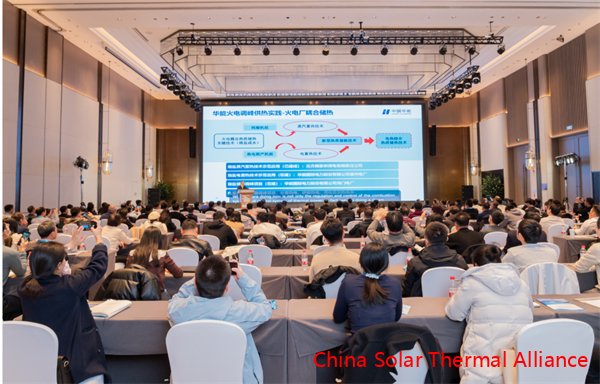
Conference in progress
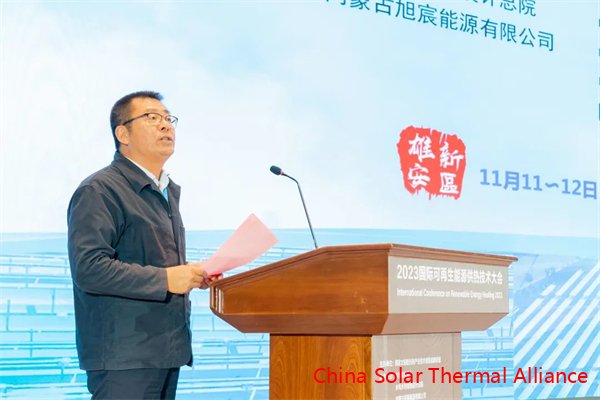
Ji Jie, Chair Professor at the University of Science and Technology of China (USTC)
The opening ceremony of the Conference was presided over by Ji Jie, chair professor at the University of Science and Technology of China (USTC) and deputy director at the Solar Thermal Utilization Committee/Concentrating Solar Power Committee of the China Renewable Energy Society (CRES).
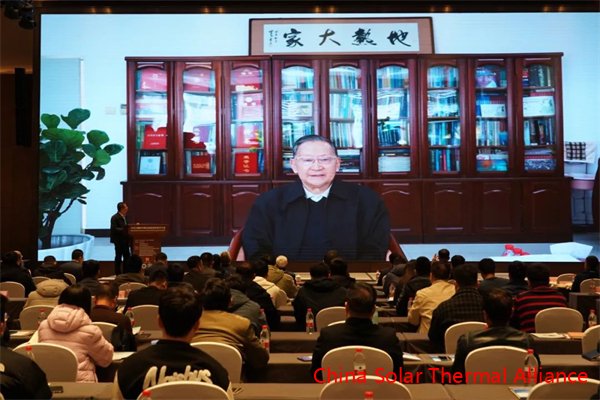
Video speech by Academician Wang Jiyang from the Chinese Academy of Sciences
Wang Jiyang, an academician of the Chinese Academy of Sciences, delivered a video speech at the Conference, expressing that China has abundant geothermal resources with huge potential for development and utilization, and the total amount of geothermal energy utilized in China has ranked first in the world for many consecutive years. As large-capacity natural energy storage spaces, geothermal energy storage reservoirs are most suitable for storing thermal energy and providing a stable supply of thermal energy in multi-energy complementary systems. They can be used to store renewable resources such as wind energy and solar energy to achieve efficient seasonal energy storage and utilization on a large scale, improve the utilization efficiency of renewable energy, and overcome the shortcomings of renewable energy such as intermittency and instability.
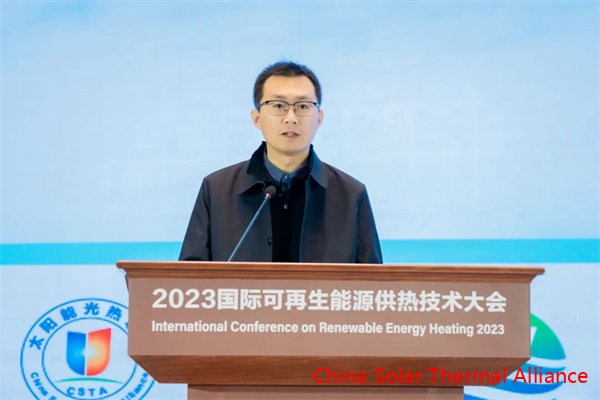
Kong Tao, Deputy Director of the Reform and Development Bureau of Xiong’an New Area
Kong Tao, deputy director of the Reform and Development Bureau of Xiong’an New Area, extended a warm welcome to all representatives from renewable energy heating-related industries coming to Xiong’an New Area. Xiong’an New Area is an important strategic fulcrum for the coordinated development of the Beijing-Tianjin-Hebei region. It represents a millennium plan, and its establishment is a major national event in China. A new highland for innovation-driven development, a green, smart, and livable new urban area, a reform and opening-up pilot area, and a demonstration zone for coordinated development will be built. Xiong’an New Area has made significant achievements in comprehensive low-carbon green growth in all fields and has been fully leveraging the advantages of its resources to promote the development and utilization of renewable energy. Its total geothermal heating area has reached about 8 million square meters and is expected to increase by about 13 million square meters in 2024. In addition, Xiong’an New Area is also promoting the high-quality development of renewable energy sources in rural areas, the integration of micro hydropower plants, micro energy storage systems and micro grids, and development model innovation. It is expected that all representatives attending the Conference make contributions to help build Xiong’an New Area into a model of sustainable urban development.
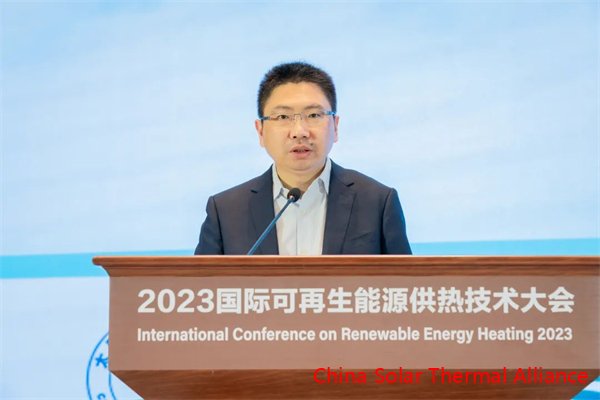
Jiang Hai, deputy director of the CREEI Renewable Energy Institute
Jiang Hai, deputy director of the CREEI Renewable Energy Institute, delivered a speech on behalf of Conference co-sponsors, stating that, as the development philosophy of “prioritizing ecological conservation and pursuing green development” gradually takes root in the people’s hearts, vigorously developing renewable energy sources and accelerating energy transition and development has become a global consensus. In the context where the development and utilization of renewable energy sources are encouraged and advocated, the use of renewable energy for heating is an inevitable choice for China to achieve its non-fossil energy utilization goals, build a clean and low-carbon society, and achieve sustainable energy development. China’s renewable energy heating industry still has great potential for future development. With China’s continued efforts to strengthen policy guidance and support, the continuous development and innovation of heating technologies, and the continuous establishment and improvement of standard systems, China’s renewable energy heating industry will definitely go further and contribute more to the achievement of the “dual carbon” goal.
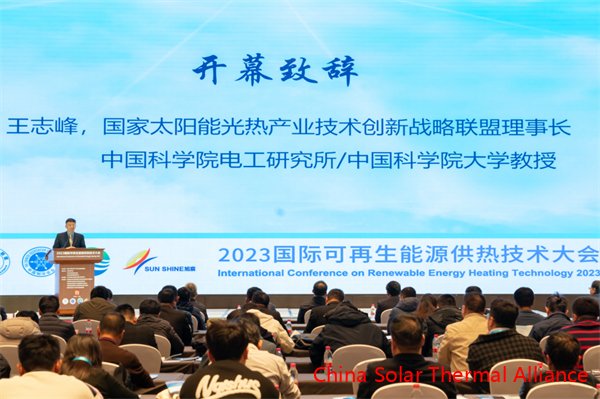
Wang Zhifeng, Chairman of CSTA
Wang Zhifeng, chairman of CSTA and researcher at the Institute of Electrical Engineering of the Chinese Academy of Science (CAS-IEE), delivered a warm welcome to all Conference attendees on behalf of the Conference sponsor. He said that two sessions of the International Conference on Renewable Energy Heating have been held (the second session was held online), and he expressed sincere gratitude to Inner Mongolia Xuchen Energy Co., Ltd, a company specialized in solar thermal energy + utilization, for its strong support. Comparing the previous two sessions, the International Conference on Renewable Energy Heating 2023 is characterized by a larger number of attendees, a stronger linkage between the government, industry, academia, research and application, a higher degree of internationalization, and a larger number of experts in renewable energy-related disciplines. He expects consensus building and in-depth, multi-faceted, and multi-dimensional cooperation and communication to take place in the renewable energy heating industry to enable the industry to mark into a new era of development and make greater accomplishments.
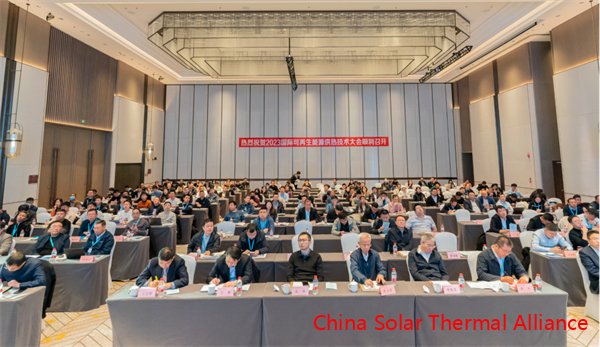
Congress in progress
Gather strength to promote technological innovations and improve energy development capabilities. In the morning of November 11, 2023 (after the opening ceremony of the Conference), experts from policy research institutes, top-down design companies, investment companies, research institutes, colleges, and universities and representatives from the Embassy of Denmark in China presented themed reports at the Conference.
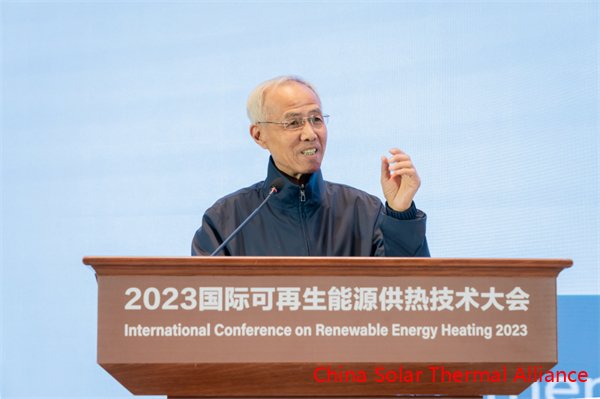
Zhang Yuqing, former deputy director of the National Energy Administration of China (NEA)
Zhang Yuqing, former deputy director of NEA, presented a report titled “Thoughts on Building a New Energy System and Achieving High-Quality Development”. It is stated in the report that the “newness” of the new energy system is reflected in new energy structures, new system forms, new industrial systems, new governance systems, new institutional structures and mechanisms, and new supervision methods; the correct practice to achieve high-quality development of the energy industry is to adhere to the principle of abandoning old modes/patterns and establishing new ones, ensure the security and stability of energy supply; persistently develop clean and low-carbon energy sources, accelerate the green and low-carbon energy transition; prioritize energy conservation, strive to improve the energy utilization efficiency; persistently develop multi-energy complementary systems and build a comprehensive energy service industry; improve the digitalization level of the energy industry through digital empowerment; develop centralized and distributed energy resources according to local conditions; adhere to the strategy of rural revitalization and actively boost the energy revolution in rural areas; adhere to the demand-oriented approach, make breakthroughs in key/core technologies and equipment; adhere to the principle of regulatory innovation, accelerate the modernization of the regulatory system’s capacity; persistently develop clean energy heating systems, vigorously increase the proportion of renewable energy.
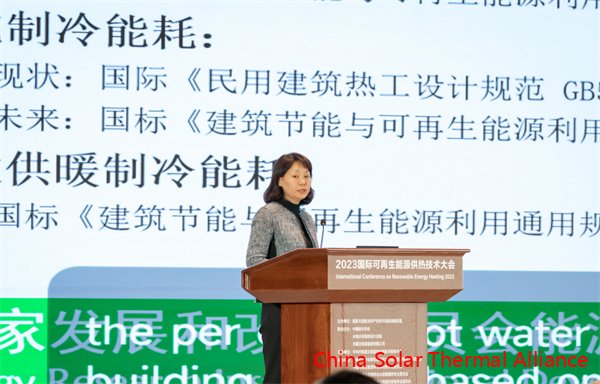
Hu Runqing, researcher at the Energy Research Institute of the National Development and Reform Commission (NDRC-ERI)
Hu Runqing, a researcher at NDRC-ERI, shared the preliminary results of studies on China’s total thermal energy consumption supported by detailed data, introduced the research methods and calculation results with respect to China’s total thermal energy consumption, and analyzed the composition (by use: domestic water heating, building heating and cooling, industrial heating, process heating) and distribution (by climate zone) of China’s total thermal energy consumption. The zero-carbon and low-carbon alternatives for thermal energy sources of different quality levels are different. In the report presented by Hu Runqing, the low-carbon and zero-carbon alternatives for thermal energy sources of different quality levels are analyzed. According to the report, the zero-carbon solutions for medium- and low-temperature heat sources are mature, but the low-carbon solutions for high-temperature and ultra-high-temperature heat sources still need to be investigated. Finding alternatives and pathways for industrial kilns is a worldwide challenge. Carbon reduction and decarbonization in the heating industry require joint efforts from the production and consumer sides.
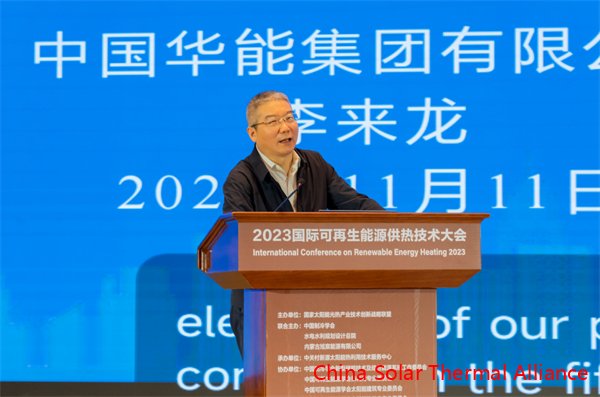
Li Lailong, director of the Planning Department and New Energy Business Department of China Huaneng Group Co., Ltd.
Li Lailong, director of the Planning Department and New Energy Business Department of China Huaneng Group Co., Ltd., presented a report titled “Practices and Thoughts of China Huaneng Group in New Energy Storage and Heating”. According to the report, developing thermal energy storage and supply technologies is an effective way to meet the long-term energy storage and peak shaving needs of new electric power systems. The key to the consumption of renewable energy in the near future is to fully leverage the peak shaving capacity of conventional units and develop innovative approaches and technologies for renewable energy consumption. China Huaneng Group has actively carried out explorations and practices in related fields such as energy storage, peak shaving and heating at thermal power plants, and renewable energy heating. In the aforementioned report, it is recommended to establish and maintain a new, diversified development model for energy storage; pay close attention to the main problems existing in the operation of power plants, strengthen the construction and application of intelligent operation and maintenance management systems; promote the coordinated development of traditional peak shaving techniques and energy storage, tap the peak-shaving potential of existing units; improve electricity market mechanisms to realize the value of energy storage and peak shaving; actively explore options for the coupled application of wind power, photovoltaic and thermal energy storage technologies; make full use of wind and solar energy to promote rural revitalization.
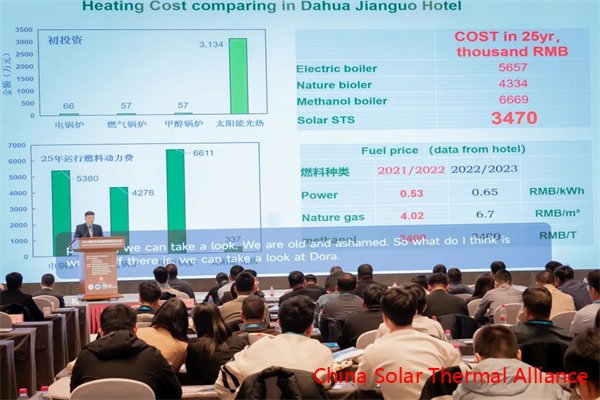
Wang Zhifeng, researcher at IEE-CAS
Prof. Wang Zhifeng’s report titled “Integration and Operation of Demonstrative Solar Heating Systems with Seasonal Solar Thermal Energy Storage” states that IEE-CAS has been focused on studying low-cost technologies for seasonal storage of solar thermal energy and source-storage-load coordinated control in the past six years, and it has established a complete technology system, thus significantly improving the cost-effectiveness of solutions to seasonable solar energy storage. In collaboration with Dahua Group, IEE-CAS has established a demonstration system, which has operated stably for three heating seasons.
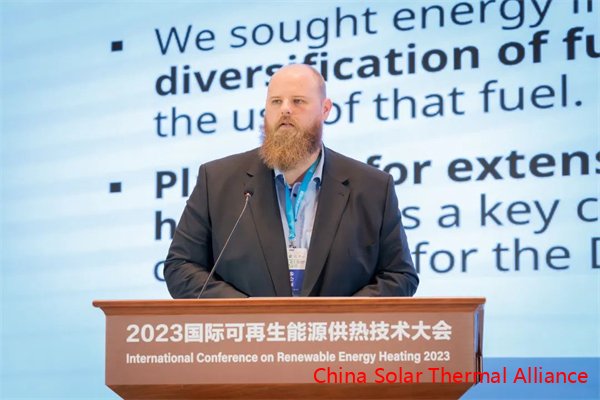
Allan Bertelsen, Sector Counsellor (Energy) at the Embassy of the Kingdom of Denmark in China
Allan Bertelsen, Sector Counselor for Energy at the Embassy of the Kingdom of Denmark in China, delivered a report titled “China-Denmark Cooperation in Clean and Renewable Energy Heating”. According to the report, for sustainable development of the renewable energy heating industry, it is necessary to establish legislative and regulatory frameworks at the national level, develop a comprehensive long-term heating plan, and speed up the implementation of the development support plan for local renewable energy central heating projects to meet the needs of end users through optimized and effective heat production. In March 2023, the CREEI, DEA (Danish Energy Agency), and UNEP (United Nations Environment Programme) Copenhagen Climate Centre jointly established the China-Denmark Clean and Renewable Energy Heating Cooperation Center.
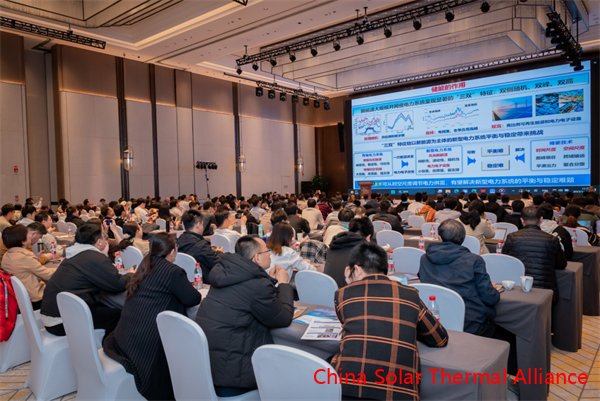
A report titled “Application of Energy Storage Technology in Heterogeneous Energy Flow Systems and Dynamic Control Methods” presented by Professor Li Mingjia from Beijing Institute of Technology
During the two-day Conference, more than 50 representatives from institutes specialized in research on national macroeconomic policies and top-down design, university research institutes/centers, suppliers of renewable energy heating systems and equipment, thermal energy storage and supply companies, and end users with heat demands in construction, oil and gas, and other industries presented their reports. More than 220 government-industry-academia-research-application representatives attended the Conference, exchanged ideas and opinions on empowering green, low-carbon development and iterative upgrading in the fields of energy, industrial heating, and building heating under the new development pattern, and explored ways to speed up the implementation of renewable energy heating applications and proceed toward a new era of heating.
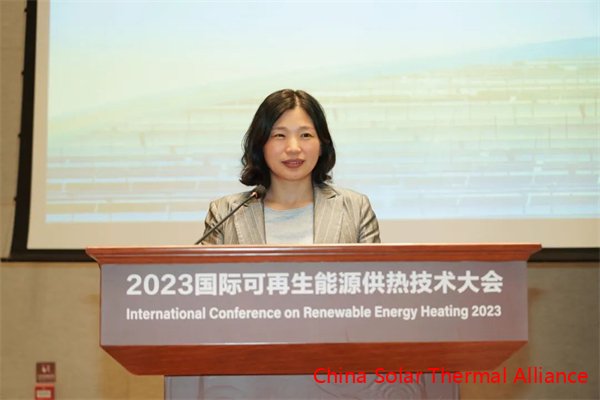
Du Fengli, Secretary-General of CSTA
Work together and start a new journey! Du Fengli, secretary-general of CSTA, delivered a speech at the closing ceremony of the Conference, stating that, as continued efforts are made to achieve the dual carbon goal, it is becoming increasingly imperative to vigorously implement the strategy of replacing conventional energy sources with renewable ones and accelerate the construction of a clean, low-carbon, safe, and efficient energy system. To complete the “Top Ten Actions for Carbon Peaking” proposed in the Action Plan for Carbon Dioxide Peaking Before 2030 issued by the State Council of the People’s Republic of China, including green and low-carbon energy transition actions, industrial carbon peaking actions, and urban and rural construction carbon peaking actions, it is necessary to increase the proportion of renewable energy in China’s energy structure and promote green and low-carbon development in industries such as energy and construction. “As a Class A strategic alliance for industrial technology innovations recognized by the Ministry of Science and Technology, CSTA works actively to build an industrial technology exchange platform and bring together the backbone forces in the energy industry. We look forward to working closely with all industry peers to promote the development of renewable energy (including geothermal energy, solar energy, biomass energy, and wind energy) heating technologies and the application of these technologies on a large scale, support and take the lead in the transformation and upgrading of renewable energy heating technologies and the leap-forward development of the renewable energy heating industry. We believe that, in the context of the dual-carbon goal, renewable energy heating technologies will surely enter a new stage of development.”


